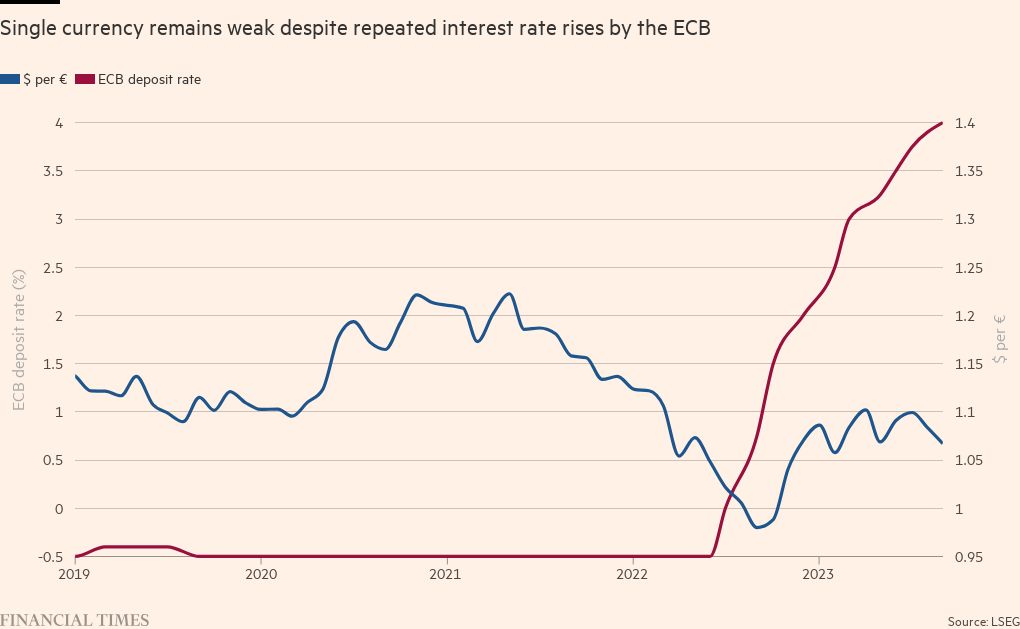

Receive free vision updates
we will send you myFT Daily Digest Email summary of latest information long term view There is news every morning.
The euro’s reaction to this week’s latest rate hike tells us a lot about how investors view the world.
On Thursday, the inflation-focused European Central Bank raised its deposit rate by a quarter of a percentage point to 4%, the highest level in the euro’s existence.
According to calculations by Deutsche Bank, this rate hike cycle is more prominent by longer historical standards. Jim writes: “If you look back to pre-ECB days and look at the Bundesbank’s previous tightening efforts, they are now tightening to the same extent in 15 months as the Bundesbank has tightened since data began in 1948 Quite a bit.” Reed and colleagues at the bank. Those topsy-turvy days of negative interest rates feel like another era.
On the face of it, this should boost the euro. After all, as a rule, what currencies love most is higher interest rates, and this decision is somewhat surprising – just a few days ago this was seen as a coin toss between holds and gains.
However, there are no dice. The currency fell 0.8% against the dollar on the day and was just above a three-month low of $1.06. It was one of the euro’s worst days of the year – there have been only five days of deeper losses before 2023, and the euro’s losing streak has now reached nine weeks. European Central Bank President Christine Lagarde reminded at the post-meeting press conference that she was still willing to raise interest rates further, but that it would not be enough to turn the tide.
“It would not be a good thing if the central bank tightened policy only to have the currency depreciate immediately after the decision,” Bas van Geffen, senior macro strategist at Rabobank, said in a note to clients.
Paul Donovan, chief economist at UBS Wealth Management, described rising interest rates as a “burden.” “As most of the current drivers of inflation in the euro area are not interest rate sensitive, the impact of this rate hike on inflation is questionable,” he said. “ECB President Christine Lagarde tried to sound hawkish at the press conference, but markets ignored the tone.”
Adjustments to expectations continue apace. Some people directly involved in the ECB’s policy decisions insist that another rate hike before the end of the year remains a possibility – a prospect that some market watchers, including Rabobank’s van Gefen, take seriously.
But overall, few actually believe the central bank will actually raise rates further, especially as the region’s economies feel the pressure of the tightening policies implemented so far and the impact of weak Chinese demand on German manufacturing. It is worth noting that central bank staff have significantly lowered their euro zone growth forecasts, lowering this year’s growth forecast to 0.7% from the previous 0.9%, and lowering next year’s growth forecast by half a percentage point to 1%.
“Raising interest rates could tip the balance,” warned Katharine Neiss, chief European economist for fixed income at PGIM. “This has the potential to trigger a rapid economic slowdown and lead to inflation below target in the medium term.”
All in all, this is not a very good recipe for euro bulls (if indeed there is any left). BNP Paribas even used the dreaded F-word (not that word) to describe the currency. It said it still prefers to use the euro as a so-called funder – euros you can sell to fund more valuable, higher-yielding bets elsewhere.
Typically, currencies only get this label when interest rates are at or near zero, or even lower (hello, Japanese yen). The term applied to a currency backed by the highest interest rates in history really highlights how the end of an era of low inflation has upended market mechanisms.
The euro’s recent decline also highlights a broader problem, namely the wide gap between how investors view the United States and virtually everywhere else. Crucially, the euro’s weakness against other currencies has been less pronounced. There has been no change against the pound or the yen since May. Instead, its exchange rate against the U.S. dollar has been particularly affected, with the U.S. dollar continuing to move higher. The DXY index, which tracks the value of a basket of other currencies, has risen more than 5% since July, while upbeat U.S. economic data has further raised the risk of a future recession.
The euro’s recent moves are another big sign that investors think Europe’s luck has run out. The surprising resilience of the euro zone economy, which supported the euro and made the region’s stocks an unusually popular choice at the start of the year, is clearly disappearing.
Kit Jewkes, macro strategist at Societe Generale in London, said: “(Money markets) are never just about monetary policy, even in the short to medium term, interest rates are usually the biggest driver of exchange rates.” But the ECB cut The fall in the euro due to growth forecasts is worth watching. “If we don’t get any positive surprises from European real economic data soon, the euro could easily fall below $1.05,” he said. Waiting with bated breath for these positive surprises may seem like a risky strategy.
katie.martin@ft.com
Svlook









